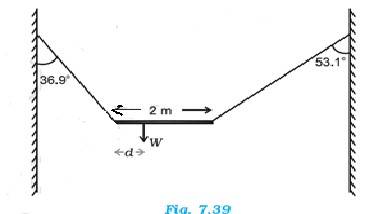physics ncert solutions class 11th
Get insights from 952 questions on physics ncert solutions class 11th, answered by students, alumni, and experts. You may also ask and answer any question you like about physics ncert solutions class 11th
Follow Ask QuestionQuestions
Discussions
Active Users
Followers
New answer posted
5 months agoContributor-Level 10
A free body diagram needs to be drawn.
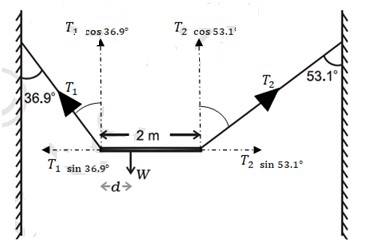
The length of the bar, l = 2 m
T1 and T2
At translational equilibrium, we have =
(T1 / T2) = ( / = 4/3
T1 = (4/3)T2
For rotational equilibrium, on taking the torque about the centre of gravity, we have
T1 x d = T2 (2-d)
T1 x 0.8d = T2 x 0.6 (2-d)
(4/3)T2 x 0.8d = T2 x 0.6 (2-d)
(4/3) x 0.8d = 0.6 (2-d)
1.07d = 1.2 – 0.6d
d = 0.72
So the c.g. of the given bar lies at 0.72 m from its left end.
New answer posted
5 months agoContributor-Level 10
Let at certain instant two particles be at points P and Q, as shown in the figure.
Angular momentum of the system about point P
= mv x 0 + mv x d = mvd ……. (i)
Angular momentum of the system about point Q
= mv x d + mv x 0 = mvd ……. (ii)
Consider a point R, which is at a distance y from point Q such that QR = y
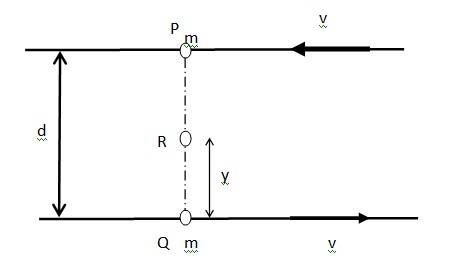
PR = d – y
Angular momentum of the system about point R
= mv x (d – y) + mv x y = mvd – mvy + mvy = mvd ……. (iii)
Comparing equations (i), (ii) and (iii) we get
= = …… (iv)
New answer posted
5 months agoContributor-Level 10
Let = , = , =
Let be a unit vector perpendicular to both b and c. Hence and a have the same direction
Now = bc
= bc = bc
Now )= a. (bc ) = abccos ? = abccos0° = abc = Volume of the parallelepiped
New answer posted
5 months agoContributor-Level 10
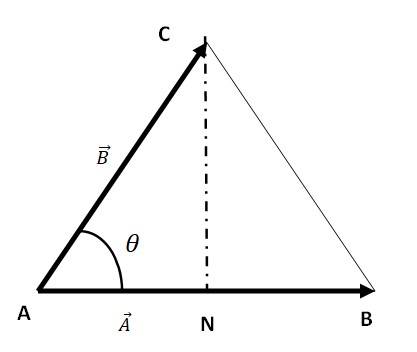
Let AB is equal to the vector a and AC be equal to the vector b.
Consider two vectors = =
= inclined at an angle
MN =
| | = | | |
The area of ΔABC, we can write the relation
Area of Δ ABC = AB =
New answer posted
5 months agoContributor-Level 10
The child is sitting on the trolley and there is no external force, hence it is a single system. The velocity of the centre of mass will not change, irrespective of any internal motion.
New answer posted
5 months agoContributor-Level 10
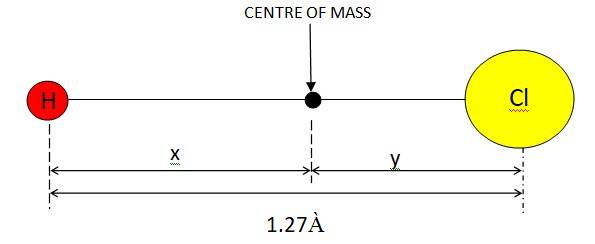
If mass of the H atom = m, mass of the Cl atom = 35.5m
Given x + y = 1,27 À
Let us assume that the centre of mass of the given molecule lies at the origin. Therefore,
We can have, : (my+35.5mx)/ (m+35.5m) = 0
mx + 35.5my = 0
x = 35.5 (1.27 – x)
x = 1.24 À
So the centre of mass lies 1.24 À from H atom
New answer posted
5 months agoContributor-Level 10
All the structures specified are symmetric bodies with uniform mass density. For all these bodies, their centre of mass will lie in their geometric centres.
Not necessarily, the centre of gravity of a circular ring is at the imaginary centre of the ring.
New answer posted
5 months agoContributor-Level 10
Initial kinetic energy of the rocket =
Initial potential energy of the rocket =
Total initial energy =
If 20% of initial kinetic energy is lost due to Martian atmosphere resistance, then only 80% of its kinetic energy helps in reaching a height
Total initial energy available = 0.8
Maximum height reached by the rocket = h
At this height, the velocity and hence the kinetic energy of the rocket becomes zero.
Total energy of the rocket at height h =
Applying the law of conservation of energy for the rocket, we can write:
0.4 =
0.4 = GM(
0.4 = GM( )
New answer posted
5 months agoContributor-Level 10
Mass of the spaceship, = 1000 kg
Mass of the Sun, M = 2 * 1030 kg
Mass of Mars, = 6.4*1023 kg
Orbital radius of Mars, R = 2.28 *108 km = 2.28 *1011 m
Radius of Mars, r = 3395 km = 3.395
Universal Gravitational constant, G = 6.67*10-11 N m2 kg–2
Potential energy of the spaceship due to the gravitational attraction of the Sun =
Potential energy of the spaceship due to the gravitational attraction of Mars=
Since the spaceship is stationed on Mars, its velocity and hence its kinetic energy will be zero
Total energy of the spaceship = = + )
The negative sign indicates that th
New answer posted
5 months agoContributor-Level 10
Yes, a body gets stuck to the surface of a star if the inward gravitational force is greater than the outward centrifugal force caused by the rotation of the star.
Gravitational force, = , where M = mass of the star = 2.5 = 5 kg
M = mass of the body, R = radius of the star = 12km = 1.2
= 2.31
Centrifugal force = mr where angular speed = 2 and angular frequency = 1.2 rev/s
mR( = m (1.2 = 6.81
Since , the body will remain stuck to the surface of the star.
Taking an Exam? Selecting a College?
Get authentic answers from experts, students and alumni that you won't find anywhere else
Sign Up on ShikshaOn Shiksha, get access to
- 65k Colleges
- 1.2k Exams
- 686k Reviews
- 1800k Answers

